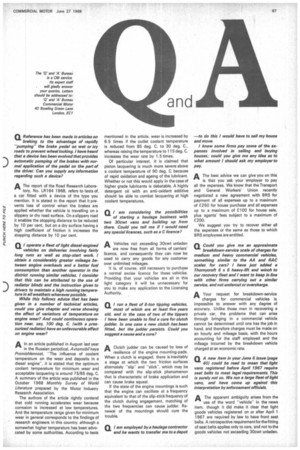• / operate a fleet of light diesel-engined vehicles on
Page 69

If you've noticed an error in this article please click here to report it so we can fix it.
deliveries involving fairly long runs as well as stop-start work. I obtain a considerably greater mileage between engine overhauls and a better fuel consumption than another operator in the district running similar vehicles. I consider that this can be attributed to the use of radiator blinds and the instruction given to drivers to maintain a high running temperature in all weathers whenever possible.
While this follows advice that has been given in a number of technical articles, could you give chapter and verse showing the effect of variations of temperature on engine wear? And could continuous operation near, say, 100 deg. C. (with a pressurized radiator) have an unfavourable effect on engine wear?
AIn an article published in August last year
in the Russian periodical, AvtomobrInaya Promishlennost, "The influence of coolant temperature on the wear and deposits in a diesel engine", it is stated that the optimum coolant temperature for minimum wear and acceptable lacquering is around 75/85 deg. C. A summary of the article was published in the October 1968 Monthly Survey of World Literature prepared by the Motor Industry Research Association.
The authors of the article rightly contend that cold running accelerates wear because corrosion is increased at low temperatures. And the temperature range given for minimum wear in general corresponds to the findings of research engineers in this country, although a somewhat higher temperature has been advocated by some authorities. According to tests mentioned in the article, wear is increased by 6.5 times if the outlet coolant temperature is reduced from 85 deg. C. to 30 deg. C., whereas raising the temperature to 115 deg. C. increases the wear rate by 1.5 times.
Of particular interest, it is claimed that piston lacquering is much more severe above a coolant temperature of 90 deg. C. because of rapid oxidation and ageing of the lubricant Whether or not this would apply in the case of higher grade lubricants is debatable. A highly detergent oil with an anti-oxidant additive should be able to combat lacquering at high coolant temperatures.


















































































































